✨You Can Touch the Times Square New Year's Eve Ball!
Find out how you can take home a piece of the old New Year's Eve ball!


New York City’s Riverside Park spans a number of neighborhoods including Harlem, Morningside Heights, and the Upper West Side. Stretching four miles from 72nd to 158th streets, the bucolic waterfront park along the Hudson was originally designed by Central Park’s landscape architect Frederick Law Olmsted. Over the past century, the park has grown and adapted to the changing landscape of New York City. Here, we explore 10 of the park’s top secrets, from a Beat Generation murder to a renowned bird sanctuary.
On Untapped New York’s brand-new Rediscover Your City Tour, you can explore the neighborhoods along Riverside Park as you uncover the secrets of Riverside Drive! Designed by Olmstead in conjunction with the park, the parkway serves as the 5th Avenue of the Upper West Side. It’s lined with gorgeous pre-war apartment buildings, historic monuments, and hidden gems waiting to be uncovered!
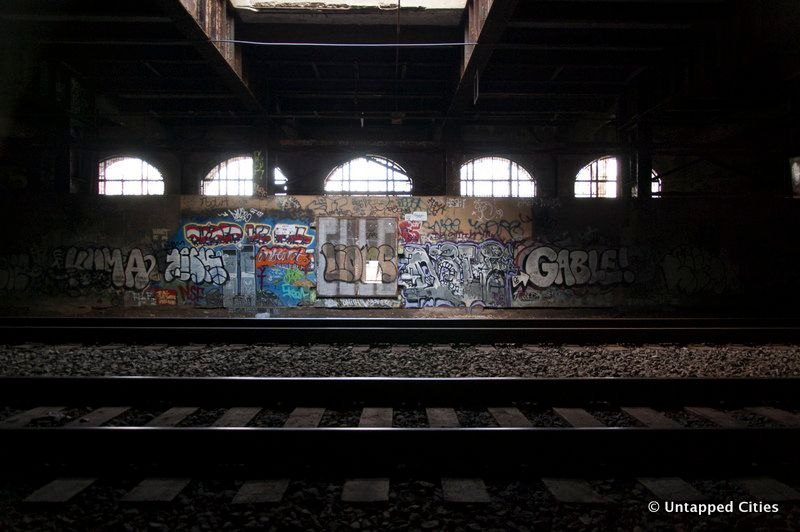
Just under the surface of Riverside Park is a three-mile-long train tunnel commonly known as the Freedom Tunnel. The tunnel was designed by Robert Moses in the 1930s to provide more park space for the neighborhood residents above. It was used for freight trains from the time it was built until the 1980s, when it was subsequently closed. Following the tunnel’s closure, the homeless sought refuge from the streets inside the vast tunnel, with hundreds of people living underground at its peak in the ’80s and ’90s.
Amtrak reopened the tunnel in 1991, and trains still run through there today. Although we don’t recommend any kind of trespassing, do be careful if you go in there. The tunnel gets its name from its best-known graffiti artist, Chris “Freedom” Pape. As Untapped Cities previously reported, Amtrak began painting over much of the art in 2009, including a number of works by Pape. See more photos here.
Riverside Park is known for its gorgeous views of Manhattan’s waterfronts, lush greenery, and myriad walking and biking paths. But in the 20th century, this green space was the scene of a murder involving a member of the Beat Generation of writers. Lucien Carr was a transfer student from Bowdoin College in Maine to New York City’s Columbia University. While at Columbia, Carr formed close friendships with famous Beat writers, including Jack Kerouac, William S. Burroughs, and Allen Ginsberg. The intelligent and handsome Carr was reportedly admired by a number of men during his lifetime, including his scoutmaster from back home in St. Louis, David Kammerer. Kammerer had developed affection toward Carr and followed him from home to New York in the name of love.
One night after the pair had some drinks, Carr and Kammerer took a walk in Riverside Park and an altercation ensued. Carr stabbed Kammerer with his Boy Scout knife and fatally wounded him. A panicked Carr sought the aid of his friends Burroughs and Kerouac to dispose of the body, but Carr turned himself in to the precinct a mere 12 hours after the incident.
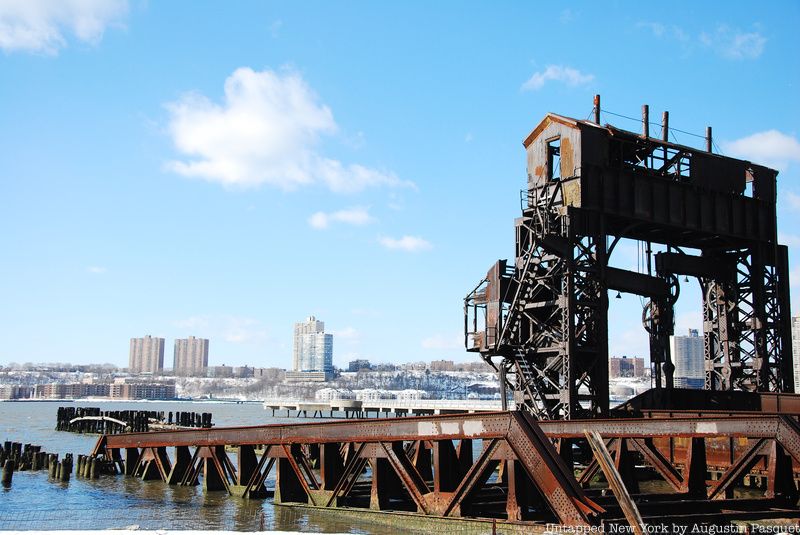
In the early 2000s, the Riverside South Planning Corporation announced plans to convert a floating bridge on West 69th Street into a ferry terminal. Even Donald Trump supported it, thinking it would take pressure off the 72nd Street 1/2/3 subway station. It was once a transfer terminal for the New York Central Railroad, facilitating the movement of freight from railyards to river barges known as “car floats.” This one is “Floating Bridge No. 4” and according to the New York Times in 2001, it has “a pair of hinged bridge decks suspended by cables from a barnlike overhead housing. Motors inside that housing lifted and lowered the decks to align them with the floats, whose position depended on the tides and the loads they carried.”
In 2008, the New York State Department of Environmental Conservation recommended against the ferry plan because dredging would destroy the habitats for aquatic plants and animals. Fortunately, the D.E.C. was not against preserving the structure itself. It has since been stabilized and forms a nice reminder of the West side’s industrial past.
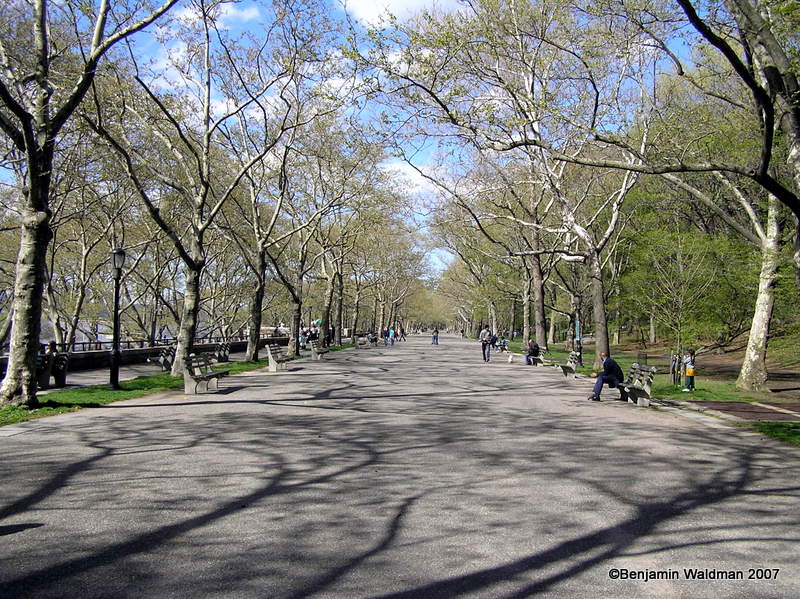
In 1865, William R. Martin, a New York City parks commissioner, was the first to propose that the area from 72nd to 125th Streets should be converted into a park. Prior to Riverside Park, the 191-acre stretch of land was undeveloped. Frederick Law Olmsted, a renowned American landscape architect of the 19th century, created the initial designs for Riverside Park and Riverside Drive. His design included a “park with a tree-lined drive curving around the valleys and rock outcroppings and overlooking the river.” In addition to Riverside Park, Olmsted was involved in the design of Central Park in Manhattan and Prospect Park in Brooklyn, both of which were created in partnership with the architect Calvert Vaux.
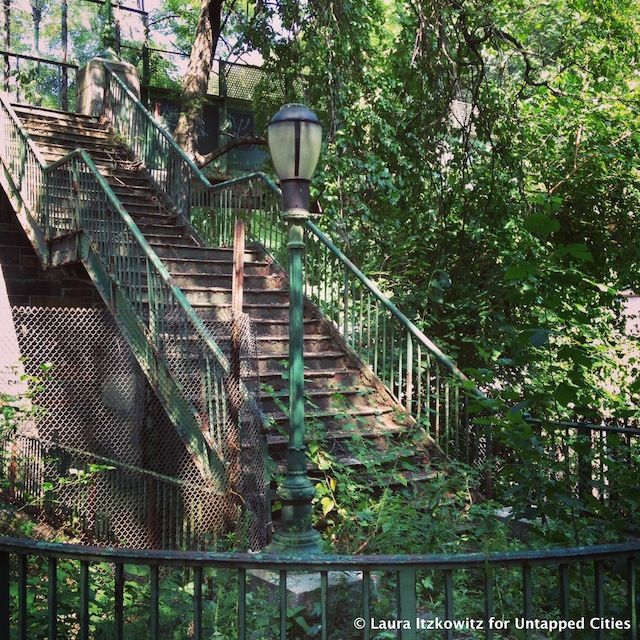
On a tip from a reader, Untapped Cities discovered a staircase in Riverside Park located near part of the train tracks in Riverside Park. The stairs are closed on both ends by fences and there is a lamp post at the bottom of the stairs. It’s unclear when the original staircase was closed.
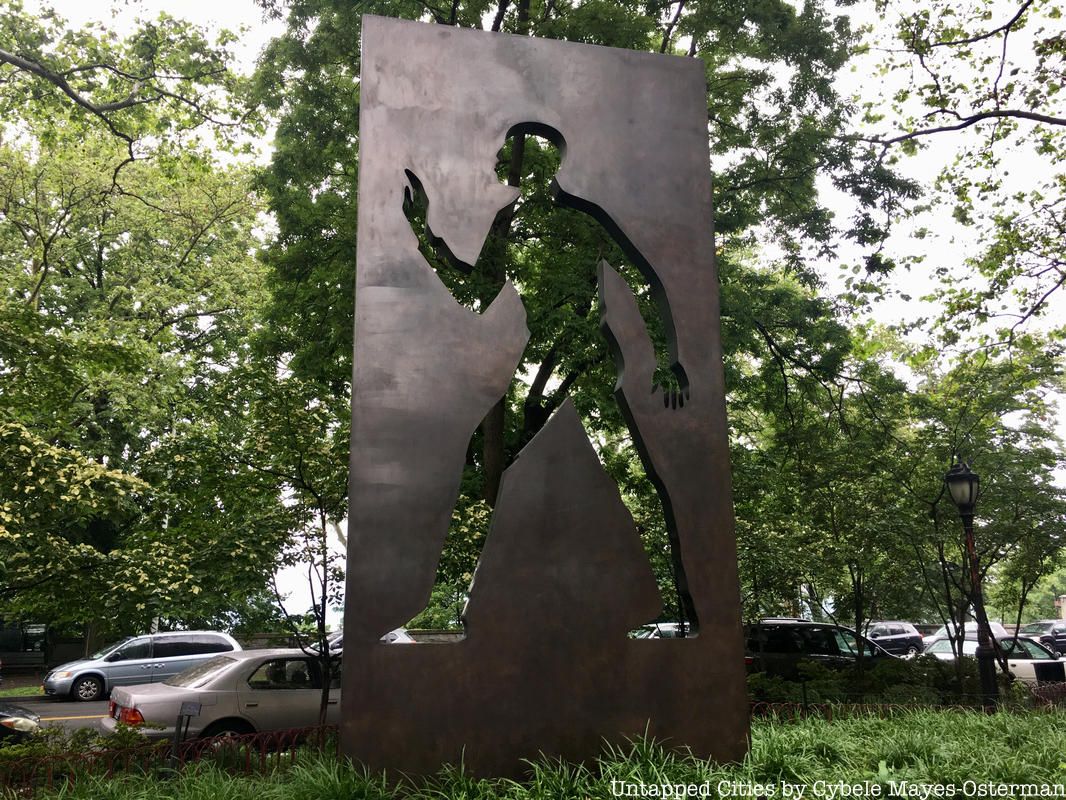
Before he was a renowned writer, Ralph Ellison was a young man who wanted to move to New York to study sculpture and photography. After dropping out of the Tuskegee Institute, a young Ellison moved from his home in Oklahoma to live at 730 Riverside Drive in New York City’s Hamilton Heights. Ellison had always enjoyed literature growing up, and decided to pursue it instead of art when he came to the city. The famed writer won both the National Medal of Arts and the National Book Award, the former of which he won for his novel Invisible Man.
In 2003, sculptor Elizabeth Catlett created an Invisible Man statue in Riverside Park. Carlett met Ellison in the 1940s while working at the George Washington Carver School adult education program. The 15-foot statue is named for Ellison’s work and features a man’s silhouette carved into bronze. Catlett’s work was selected by a competition sponsored by the Riverside Park Fund and the Ralph Ellison Memorial Committee.
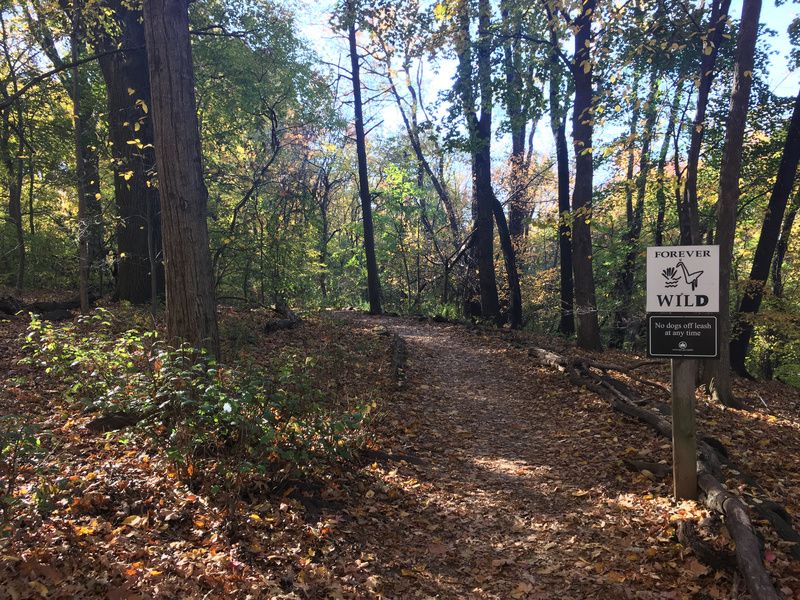
From 116th to 124th Streets in Riverside Park, is one of New York City Audubon’s bird sanctuaries. According to the New York City Audubon’s website, over 177 species of bird have been seen at the bird sanctuary in the past 30 years. One unique feature of the sanctuary is the Bird Drip, a “man-made water source where birds come to drink and bathe” just south of 120th Street. The Bird Drip is active from mid-April to mid-May and September to mid-October. It has reportedly attracted over 80 species of birds including wild turkeys, cuckoos, orioles and warblers. For more information about bird watching in Riverside Park, visit the New York City Audubon website.
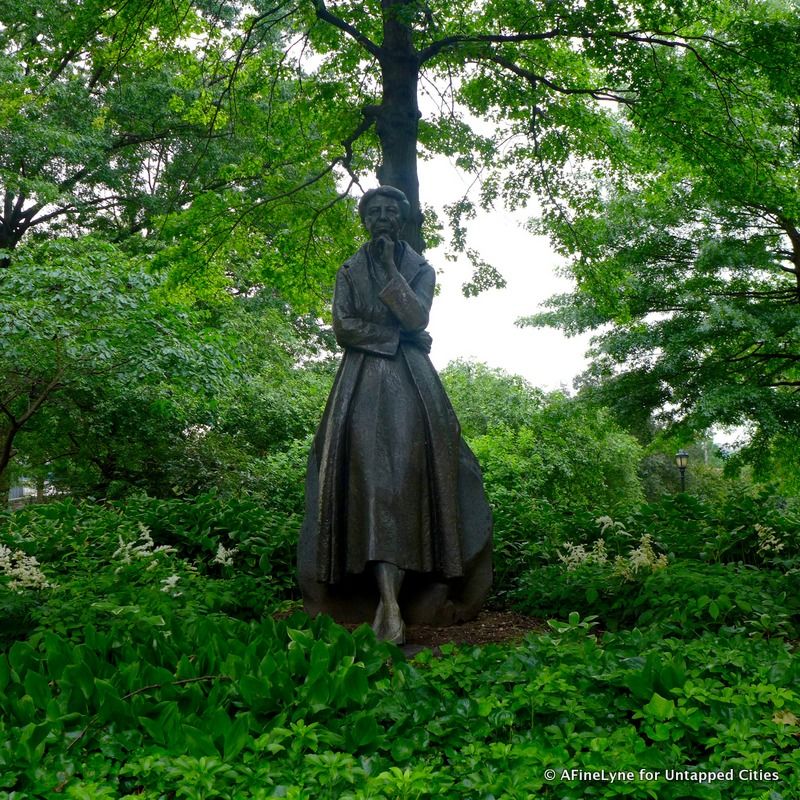
Eleanor Roosevelt was the wife of the 32nd president of the United States, Franklin Delano Roosevelt. The former first lady was born in 1884 to a prominent New York family but was orphaned at 10 when both of her parents died within two years of each other. Despite these hardships, she grew up to become both the First Lady of New York and the First Lady of the United States. Roosevelt was involved in a number of important organizations in her lifetime including the League of Women Voters, the American Red Cross, and the Women’s Trade Union League.
Her statue was designed by Penelope Jencks and was dedicated on October 5, 1996 in the presence of Hillary Clinton, who was first lady at the time. The words engraved on the statue are famous quotes from both Roosevelt and Adlai Stevenson, including a quote by Roosevelt about the importance of human rights and equality.
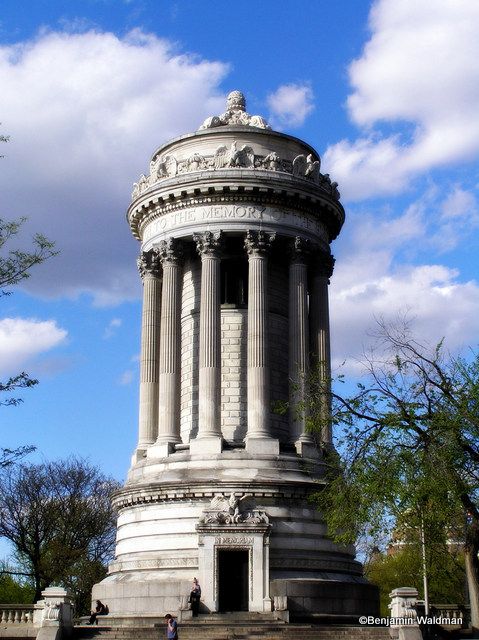
At 89th Street and Riverside Drive is the Soldiers’ and Sailors’ Monument, a large tower that piques the curiosity of parkgoers. The memorial was built in honor of those who fought in the Civil War, and has been opened sporadically for public viewing through the years. Mayor William Lafayette Strong suggested the Grand Army Plaza at 59th Street and 5th Avenue as the location of the memorial. Another site at the Riverside Drive viaduct was suggested as were a number of other subsequent places. The final location at 89th Street was finalized in 1899 and the memorial was dedicated in 1902. By 1950 the memorial had greatly deteriorated, and money was put aside for its renovation by 1960. In 1976 the monument was dedicated as a New York City Landmark.
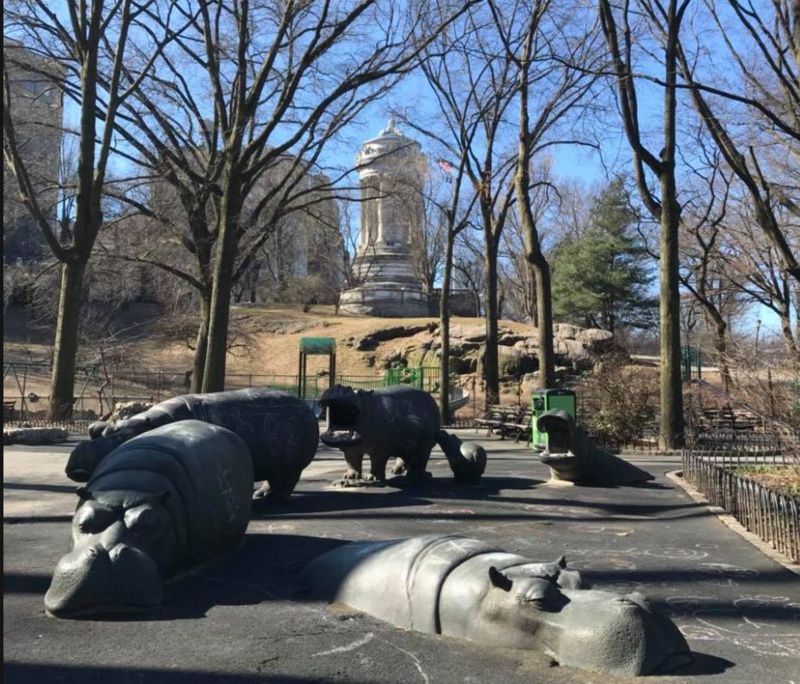
One of the smallest parts of Riverside Park is full of big surprises: hippos. The Hippo Playground was created in 1937, but the hippos were not put in until 1993 when the Hippo Playground Project hired a designer to create the statues. Some of the hippos appear to be “submerged” in the ground, while other standing statues are scattered around the park seemingly interacting with their fellow hippos. The hippos recall a similar project of 27 seal sculptures designed by Gerry Augustine Lynas in New York’s East River Park. Similarly to the East River Park seals, the hippos double as sprinklers for children and adults to frolic through during the warmer months.
Next, check out 10 Secrets of Central Park
Subscribe to our newsletter